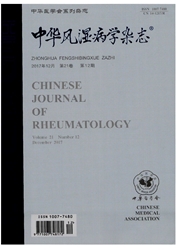

 中文摘要:
中文摘要:
目的检测系统性红斑狼疮(SLE)患者外周血抗EB病毒一病毒衣壳抗原(VCA)IgG、IgA、IgM抗体的表达,探讨EB病毒感染与SLE及干扰素诱导基因表达水平的相关性。方法收集55例SLE患者和29名健康人外周血标本,用酶联免疫吸附试验(ELISA)检测血浆中抗EB病毒抗体,采用t检验比较SLE与健康人抗EB病毒抗体的差异,分析SLE临床表现及活动度指标[SLE疾病活动指数(SLEDAI)积分]与抗EB病毒抗体水平的相关性。其中33例SLE患者和26名健康人外周血标本分离有核细胞,提取RNA,以实时荧光定量聚合酶链反应(PCR)检测干扰素诱导基因人黏液病毒抗性蛋白1(MX1)、2’,5’-寡腺苷酸样合成酶(OASL)、2’,5’-寡腺苷酸合成酶1(OAS1)、α-干扰素诱导蛋白15(ISG15)、淋巴细胞抗原6复合体E(LY6E)的mRNA表达水平,采用Spearman相关分析法分析抗EB病毒抗体与干扰素诱导基因表达水平的相关性。结果①SEE患者外周血抗EB病毒抗体浓度显著高于健康对照组[IgG(41±6)与(19±6)U/ml;IgA(15.4±1.8)与(8.3±2.1)U/ml;IgM(7.8±1.0)与(3.7±1.2)U/ml](P均〈0.01)。②SLE患者抗EB病毒抗体与SLEDAI积分及临床表现无相关性(P均〉0.05)。③SLE患者干扰素诱导基因表达及干扰素指数显著高于健康对照组(干扰素指数11±13与0±3)(P均〈0.05);但是与抗EB病毒抗体水平无相关性(P均〉0.05)。结论抗EB病毒抗体在SLE患者中高表达,但与SLE疾病活动度、临床表现及干扰素诱导基因的高表达无相关性,提示SLE患者Ⅰ型干扰素通路的紊乱可能受多种因素影响,抗EB病毒感染不能作为单一的或主要的影响因素;抗EB病毒感染可能参与了SLE发病,而非促进病情活动。
 英文摘要:
英文摘要:
Objective To study the role of anti-EBV antibody in the development of systemic lupus erythematosus (SLE). Methods Peripheral blood was obtained from 55 SLE patients and 29 normal controls, and anti-EBV-VCA IgG, IgA, IgM antibody was detected by enzyme-linked immunosorbent assay (ELISA). Total RNA was extracted from peripheral blood of 33 SLE patients and 26 normal controls and then reverse transcribed into complementary DNA. Real-time PCR technique was used to determine gene expressions at the transcription level. Comparison of anti-EBV antibody level and interferon inducible gene expression was made between SLE patients and normal controls by t-test. The associations between anti-EBV antibody level, lupus activity and IFN inducible gene expression were analyzed by Spearman's correlation analysis. Results (1) The levels of anti-EBV antibodies in SLE patients were significantly increased as compared to those in the normal controls [IgG(41±6) vs (19±6) U/ml, IgA (15.4±1.8) vs (8.3±2.1) U/ml, IgM (7.8±1.0) vs (3.7±1.2) U/roll (all P〈0.01). (2) The levels of anti-EBV antibody in SLE patients were not correlated with lupus disease activity as well as the clinical parameters in SLE patients (all P〉0.05). (3) IFN inducible genes were significantly elevated in SLE patients as compared to norrnal controls [IFN scores 11±13 vs 0±3] (all P〈0.05), but not correlated with the levels of anti-EBV antibody in patients ( all P〉0.05 ). Conclusion Anti-EBV antibody is overproduced in SLE patients but not associated with disease activity as well as the expression level of several major types of Ⅰ IFN inducible genes, suggesting that EBV infection may not be a major factor mediating the activation of IFN pathway and consequently the exacerbation of SLE.
 同期刊论文项目
同期刊论文项目
 同项目期刊论文
同项目期刊论文
 期刊信息
期刊信息
